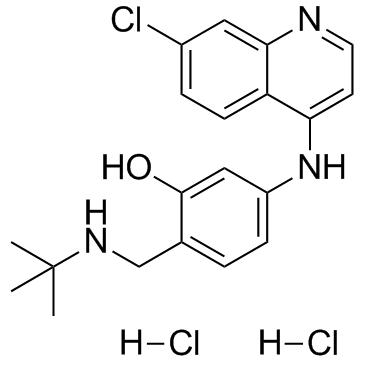1010411-21-8
| Name | 5-[(7-Chloro-4-quinolinyl)amino]-2-{[(2-methyl-2-propanyl)amino]methyl}phenol dihydrochloride |
|---|---|
| Synonyms |
MFCD16627991
5-[(7-Chloro-4-quinolinyl)amino]-2-{[(2-methyl-2-propanyl)amino]methyl}phenol dihydrochloride Phenol, 5-[(7-chloro-4-quinolinyl)amino]-2-[[(1,1-dimethylethyl)amino]methyl]-, hydrochloride (1:2) GSK369796 GSK369796 Dihydrochloride |
| Description | GSK369796 Dihydrochloride is an affordable and effective antimalarial and inhibits hERG potassium ion channel repolarization with an IC50 of 7.5 μM. |
|---|---|
| Related Catalog | |
| Target |
IC50: 7.5 μM (hERG potassium ion channel)[1] |
| In Vitro | In vitro, GSK369796 Dihydrochloride can inhibit the growth of Plasmodium falciparum strains 3D7c, HB3c and K1d, with IC50s of 11.2±2.2, 12.6±5.3 and 13.2±3.2 nM, respectively. Protein binding is higher for GSK369796 Dihydrochloride (compound 4) compare to desethyl amodiaquine in the mouse (93 vs 74%) but similar in human (88 vs 86%). GSK369796 Dihydrochloride can also inhibit hERG potassium ion channel repolarization with an IC50 of 7.5±0.8 μM[1]. |
| In Vivo | In vivo, GSK369796 Dihydrochloride can inhibit the growth of Plasmodium berghei ANKA with ED50 and ED90 of 2.8 and 4.7 mg/kg, respectively[1]. |
| Cell Assay | Assays are performed in sterile 96-well microtiter plates, each plate contains 200 mL of parasite culture (2% parasitemia, 0.5% hematocrit) with or without 10 mL drug dilutions (including GSK369796 Dihydrochloride). Each drug is tested in triplicate and parasite growth is compared to control wells (which constitutes 100% parasite growth). Cultures are incubated for a further 24 h before they are harvested onto filter mats, dried for 1 h at 55 °C, and counted. IC50 values are calculated[1]. |
| Animal Admin | The efficacy of selected 4-aminoquinolines (including GSK369796 Dihydrochloride) is measured against P. yoelii or P. berghei in a 4-day test. 28 Cohorts of age-matched female mice are infected iv with 6.4×106 or 10.0×106 parasites obtained from infected donors, and the mice are randomly distributed in groups of n=5 mice/group (day 0). Treatments are administered from day 0 (one hour after infection) until day 3. The therapeutic efficacy of compounds (including GSK369796 Dihydrochloride) is expressed as the effective dose that reduces parasitemia by 50% (ED50) and 90% (ED90) with respect to vehicle treated groups (ED90) and the dose that achieved eradication of parasitemia until day 23 after infection (NRL). All compounds (including GSK369796 Dihydrochloride) and corresponding vehicles are administered orally at 20 mg/kg or subcutaneously at 10 mg/kg, as appropriate[1]. |
| References |
| Molecular Formula | C20H24Cl3N3O |
|---|---|
| Molecular Weight | 428.783 |
| Exact Mass | 427.098511 |
| Storage condition | 2-8℃ |
